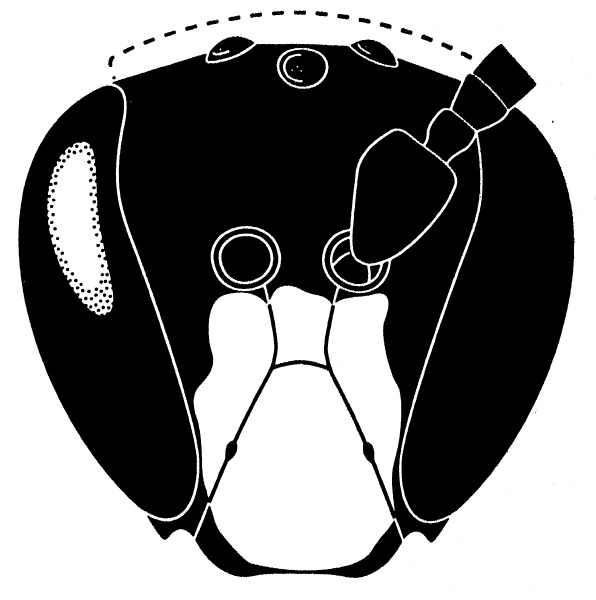Hylaeus in Hawaii

Hylaeus in Hawaii |

|
Hylaeus anthracinusIslands: Oahu, Molokai, Lanai, Kahoolawe, Maui, HawaiiLocations: Oahu - (Kaena Point, Ka Iwi, Kahuku, Malaekahana) Molokai - (Moomomi) Kahoolawe - (Pali o Kalapakea) Maui - (Manawainui West, Kanaio NAR) Hawaii - (Fairmont Orchid, Hilton Waikaloa, Holoholokai Park, Kaulana, Keahole Point, Kiholo Dunes, Kohanaiki, Kolea, Lauhinewai, Ooma, Puako, South Point) Habitats: Coast and dry lowlands Plants: Argemone, Capparis, Chamaesyce, Ipomoea, Myoporum, Pluchea, Scaevola, Sesbania, Sida, Tournefortia Xerces: Hylaeus anthracinus is a coastal bee endemic to the islands of Oahu, Molokai, Kahoolawe, Maui, Hawaii, and formerly Lanai in Hawaii. It is distinguished by the single large facial mark, sometimes filling the entire area below the antennae. Although it can sometimes be found in moderate numbers, habitat destruction has caused its range to contract significantly. Species Profile 
Insects of Hawaii: This once-widespread species appears to have declined precipitously with the loss of coastal habitat, and now appears to be restricted to one or a few localities on each island. However, it appears to have a significant population on the small, uninhabited island of Kahoolawe. Hylaeus anthracinus is not closely related to the other species (e.g., H. difficilis) with an undilated S8 process and a single central facial mark. The female has three small teeth on the mandible, rather than two large, a unique feature shared only with its sister species, H. flavifrons (sometimes other species may appear similar due to wear). It typically occurs in company with H. longiceps or H.flavipes, from which the females can also be distinguished by the erect dark hairs ofT6. This once-widespread species appears to have declined precipitously with the loss of coastal habitat, and now appears to be restricted to one or a few localities on each island. However, it appears to have a significant population on the small, uninhabited island of Kahoolawe. Hylaeus anthracinus is not closely related to the other species (e.g., H. difficilis) with an undilated S8 process and a single central facial mark. The female has three small teeth on the mandible, rather than two large, a unique feature shared only with its sister species, H. flavifrons (sometimes other species may appear similar due to wear). It typically occurs in company with H. longiceps or H. flavipes, from which the females can also be distinguished by the erect dark hairs of T6. Insects of Hawaii Volume 17 
UH/DOD: This was the only target species to be found in significant numbers. On Hawaii, H. anthracinus occurs along several stretches of coastline in the North Kona-Kohala area: in Puako, from Puako village to the southern end of the Fairmont Orchid hotel property; in Waikoloa, along the frontage of the Hilton Waikoloa Hotel and Kolea condominium property; in Kiholo, at Luahinewai and Mano Point; and the largest, from Keahole Point to Kohanaiki, where it co-occurs with H. difficilis (Figure 4). Remarkably, this includes two of the large resorts that have been built in this region, indicating that they can survive contact with development. Throughout the inhabited area, they can often be found in extremely high densities, with 20-50 or more bees flying around a single Heliotropium tree at any given time - much more than even the most abundant of the common montane species. Hylaeus near military lands 
Other: On telling apart difficilis and anthracinus: Coastal and lowland populations of H. difficilis often have males with wider lateral face marks than normal, resembling H. anthracinus, but these usually also have yellow marks on the legs. H. anthracinus may sometimes have narrower lateral marks like H. difficilis but is always all-black except for the face. |

|